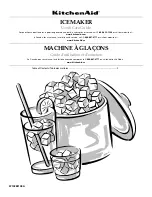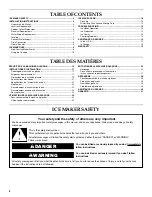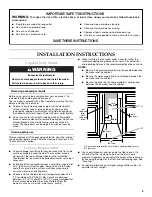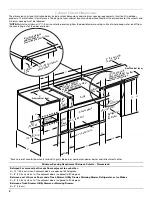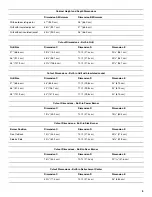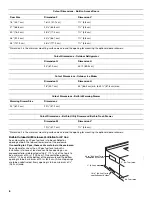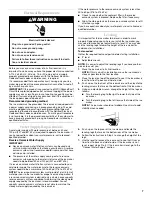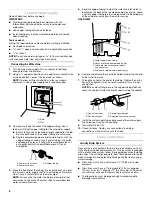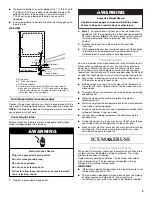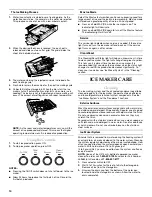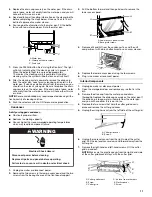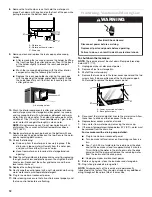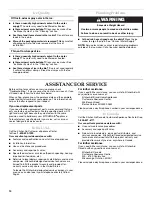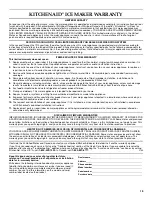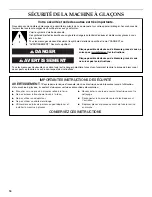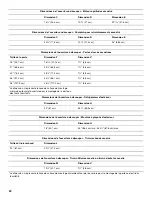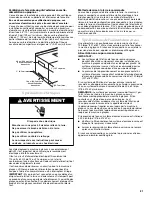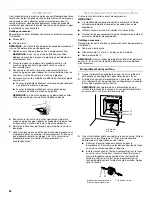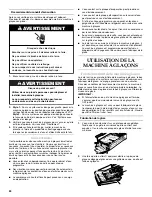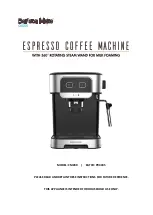
9
■
The ideal installation has a standpipe with a 1
¹⁄₂
" (3.81 cm) to
2" (5.08 cm) PVC drain reducer installed directly below the
outlet of the drain tube as shown. You must maintain a
1" (2.54 cm) air gap between the drain hose and the
standpipe.
■
It may be desirable to insulate the drain line thoroughly up to
the drain inlet.
SIDE VIEW
Drain Pump System (on some models)
Connect the ice maker drain to your drain in accordance with the
International Plumbing Code and any local codes and ordinances.
NOTE: If the drain hose becomes twisted and water cannot drain,
your ice maker will not work.
Connecting the Drain
After ensuring that the drain system is adequate, follow these
steps to properly place the ice maker:
1. Plug into a grounded 3 prong outlet.
2. Style 1 - For gravity drain system, push the ice maker into
position so that the ice maker drain tube is positioned over the
PVC drain reducer. Style 2 - For drain pump system connect
the drain pump outlet hose to the drain. See “Drain Pump
System.”
3. Recheck the ice maker to be sure that it is level. See
“Leveling.”
4. If it is required by your local sanitation code, seal the cabinet
to the floor with an approved caulking compound after all
water and electrical connections have been made.
Normal Sounds
Your new ice maker may make sounds that are not familiar to you.
Because the sounds are new to you, you might be concerned
about them. Most of the new sounds are normal. Hard surfaces
such as floors, walls and cabinets can make the sounds seem
louder than they actually are. The following describes the kinds of
sounds that might be new to you and what may be making them.
■
You will hear a buzzing sound when the water valve opens to
fill the water reservoir for each cycle.
■
Rattling noises may come from the flow of the refrigerant or
the water line. Items stored on top of the ice maker can also
make noises.
■
The high-efficiency compressor may make a pulsating or high
pitched sound.
■
Water running over the evaporator plate may make a
splashing sound.
■
Water running from the evaporator plate to the water reservoir
may make a splashing sound.
■
As each cycle ends, you may hear a gurgling sound due to the
refrigerant flowing in your ice maker.
■
You may hear air being forced over the condenser by the
condenser fan.
■
During the harvest cycle, you may hear a “thud” when the ice
sheet slides from the evaporator onto the cutter grid.
■
When you first start the ice maker, you may hear water running
continuously. The ice maker is programmed to run a rinse
cycle before it begins to make ice.
ICE MAKER USE
How Your Ice Maker Works
When you first start your ice maker, the water pan will fill and the
system will rinse itself before starting to make ice. The rinsing
process takes about 5 minutes.
Under normal operating conditions, the ice maker will cycle at
preset temperatures. The ice level sensor located in the ice
storage bin will monitor the ice levels.
IMPORTANT:
■
If the water supply to the ice maker is turned off, be sure to set
the ice maker control to OFF.
■
The ice maker is designed to make clear ice from the majority
of water sources on a daily basis. If your results are
unsatisfactory, your water may need to be filtered or treated.
A. Drain hose
B. 1" (2.54 cm) air gap
C. PVC drain reducer
D. Center of drain should be 20" (50.80 cm) from front of
door, with or without the
³⁄₄
" (1.91 cm) panel on the door.
The drain should also be centered from left to right (8
¹³⁄₁₆
"
from either side of the ice maker).
1" (2.5 cm)
20" (50.80 cm)
1
⁷⁄₈
"
(1.9 cm)
B
D
C
A
2" - 1
¹⁄₂
"
(5 cm - 3.8 cm)
Electrical Shock Hazard
Plug into a grounded 3 prong outlet.
Do not remove ground prong.
Do not use an adapter.
Do not use an extension cord.
Failure to follow these instructions can result in death,
fire, or electrical shock.
WARNING
WARNING
Excessive Weight Hazard
Use two or more people to move and install ice maker.
Failure to do so can result in back or other injury.

